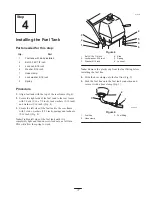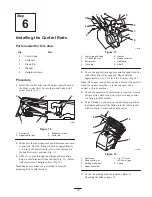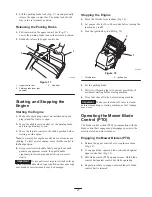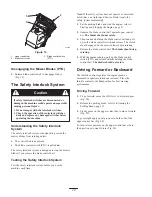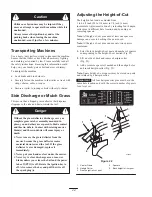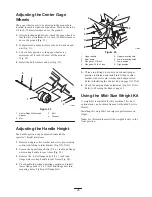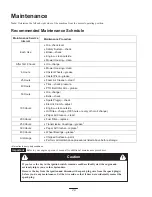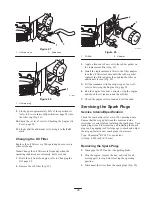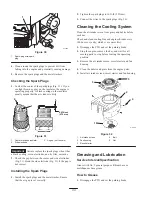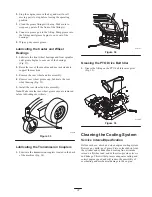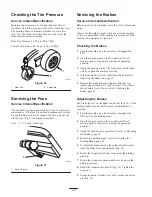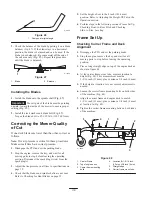
22
1
3
2
m–6443
Figure 19
1.
Upper control bar
2.
Blade control bail
3.
Blade control switch
(PTO)
Disengaging the Mower Blades (PTO)
1. Release blade control bail to disengage blades
(Fig. 19).
The Safety Interlock System
If safety interlock switches are disconnected or
damaged the machine could operate unexpectedly
causing personal injury.
•
Do not tamper with the interlock switches.
•
Check the operation of the interlock switches
daily and replace any damaged switches before
operating the machine.
Caution
Understanding the Safety Interlock
System
The safety interlock system is designed to prevent the
mower blades from rotating unless:
•
The control bail is depressed.
•
The blade control switch (PTO) is pulled on.
The safety interlock system is designed to stop the mower
blades if you release the blade control bail.
Testing the Safety Interlock System
Test the safety interlock system before you use the
machine each time.
Note: If the safety system does not operate as described
below, have an Authorized Service Dealer repair the
safety system immediately.
1. Set the parking brake and start the engine; refer to
Starting and Stopping the Engine, page 21.
2. Squeeze the blade control bail against upper control
bar. The blades should not rotate.
3. Then continue holding the blade control bail and pull
up on the blade control switch and release. The clutch
should engage and the mower blades begin rotating.
4. Release the blade control bail. The blades should stop
rotating.
5. With the engine running, pull up the blade control
switch (PTO) and release without holding the blade
control bail. The blades should not rotate.
Driving Forward or Backward
The throttle control regulates the engine speed as
measured in rpm (revolutions per minute). Place the
throttle control in the fast position for best mowing
performance.
Driving Forward
1. To go forward, move the shift lever to a forward gear
(Fig. 20).
2. Release the parking brake; refer to Releasing the
Parking Brake, page 21.
3. Slowly press on the upper control bar to move forward
(Fig. 20).
To go straight, apply equal pressure to both ends of the
upper control bar (Fig. 20).
To turn, release pressure on the upper control bar side in
the direction you want to turn (Fig. 20).










